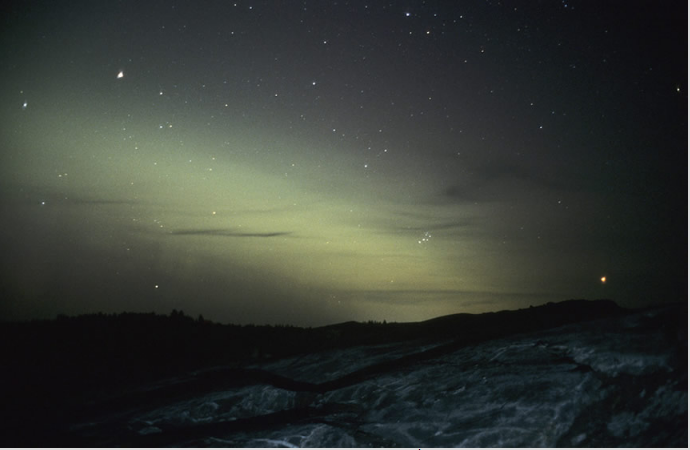Aurora, Northern Lights Image - Sweden
Aurora, Northern Lights Image - Sweden
The mesmerizing natural phenomenon known as the Northern Lights, or Aurora Borealis, has captivated people for centuries with its ethereal beauty. One stunning image that showcases this celestial spectacle was captured in Sweden by P-M Hedén in September 2005. The diffuse aurora displayed over Riala/Norrtälje is a sight to behold, with its vibrant colors and intricate patterns dancing across the night sky.
Auroras occur when charged particles from the Sun collide with atoms and molecules in Earth's atmosphere, resulting in the emission of light. The specific colors observed in an aurora depend on the type of gas involved in the collision. In the case of the Northern Lights, the dominant gas is oxygen, which produces green and red hues. However, other atmospheric gases can contribute to the display, adding shades of blue and purple to the mix.
Sweden, with its high latitude and relatively low levels of light pollution, provides an ideal location for witnessing the Northern Lights. The country's northern regions, such as Lapland and Kiruna, are particularly renowned for offering spectacular views of this natural wonder. The image captured by P-M Hedén serves as a testament to the breathtaking displays that can be experienced in Swedish skies.
The diffuse aurora seen in the image is characterized by its soft and evenly spread glow. This type of aurora often covers a large portion of the sky, creating a mesmerizing backdrop against which the intricate details of the atmospheric display can be observed. The diffuse nature of this particular aurora suggests that the charged particles from the Sun were relatively energetic, resulting in widespread ionization of the upper atmosphere.
One notable feature of the image is the presence of faint rays extending upwards from the main auroral band. These rays are known as "curtains" and are a common occurrence during intense auroral activity. Curtains are formed when the charged particles follow the Earth's magnetic field lines, creating a vertical alignment of the emission. The result is a stunning visual effect reminiscent of cascading curtains of light.
The vibrant colors visible in the image are a result of the different altitudes at which the charged particles collide with the atmosphere. Green light, for example, is emitted when oxygen atoms at an altitude of approximately 100 kilometers are excited by the incoming particles. Red light, on the other hand, is emitted at higher altitudes of around 200 kilometers. The interplay of these various altitudes gives rise to the rich palette of colors observed in the diffuse aurora.
The image captured by P-M Hedén serves as a reminder of the ever-changing and unpredictable nature of the Northern Lights. The intensity and visibility of auroras can vary greatly depending on factors such as solar activity, atmospheric conditions, and geographical location. Each viewing experience is unique, making every encounter with the Northern Lights a truly awe-inspiring event.
In conclusion, the Northern Lights image taken in Sweden by P-M Hedén showcases the beauty and complexity of the auroral phenomenon. From the diffuse glow to the intricate curtains and vibrant colors, this image encapsulates the magic that can be witnessed when charged particles from the Sun interact with Earth's atmosphere. Sweden's geographical location and low light pollution make it an ideal destination for experiencing the Northern Lights firsthand. So, if you ever find yourself in this enchanting country, be sure to keep an eye on the night sky for a chance to witness this celestial spectacle in all its glory.

Diffuse aurora over Riala/Norrtälje, Sweden imaged by P-M Hedén (Astro and atmospheric images) September 2005. Image ©P-M Hedén, shown with permission.
Note: this article has been automatically converted from the old site and may not appear as intended. You can find the original article here.
Reference Atmospheric Optics
If you use any of the definitions, information, or data presented on Atmospheric Optics, please copy the link or reference below to properly credit us as the reference source. Thank you!
-
<a href="https://atoptics.co.uk/blog/aurora-northern-lights-image-sweden/">Aurora, Northern Lights Image - Sweden</a>
-
"Aurora, Northern Lights Image - Sweden". Atmospheric Optics. Accessed on April 19, 2024. https://atoptics.co.uk/blog/aurora-northern-lights-image-sweden/.
-
"Aurora, Northern Lights Image - Sweden". Atmospheric Optics, https://atoptics.co.uk/blog/aurora-northern-lights-image-sweden/. Accessed 19 April, 2024
-
Aurora, Northern Lights Image - Sweden. Atmospheric Optics. Retrieved from https://atoptics.co.uk/blog/aurora-northern-lights-image-sweden/.